We are often puzzled when it comes to understanding cats’ behavior. Carole C. Wilbourn, cat therapist, has written a fascinating book called “Cat Talk: What Your Cat Is Trying To Tell You.” This book may give you valuable clues.
Before we delve into the book, we need to understand some things about the cat brain. Did you know that the brain of your cat has an emotional center just as in the human brain? Therefore, many of the cat’s responses may have an emotional cause.
How does a cat release emotions? Certainly not by crying tears, as we might do. Other parts of its body can be involved in giving an emotional response, such as fur rising, flicking tail, hissing or growling. They often “talk” to us to try to convey their message. And, though they cannot cry, they can purr.
The purr, of course, is often an expression of happiness and contentment. However, it can also express many other feelings. A cat will purr when it is ill or if it is in pain. He can use the purr to heal, and it can promote bone growth. A mother cat purrs during childbirth, and afterward, to her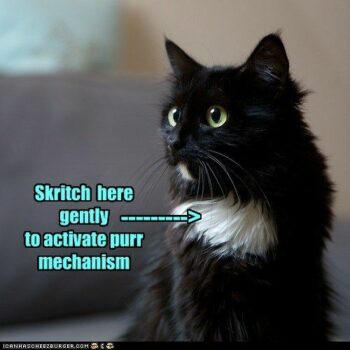 kittens.
kittens.
When a cat purrs, its whole body can vibrate, allowing the healing power of the purr to spread through the cat’s entire body. Have you ever tried one of those beds that vibrate when you add a coin or two to its control box? It’s very relaxing, and might be the closest we can get to experiencing how the body vibrates to the purr’s tune.
Carole Wilbourn explains at the beginning of her book that, as a cat therapist, she tries to help people understand their cat’s daily needs, allowing both person and cat to reach good physical and emotional health.
When a cat develops an emotional problem, this can often trigger a medical one. Carole has observed that if a cat’s emotions are well-balanced, his behavior achieves this balance as well.
In 1973, Carole and her husband, Paul, opened The Cat Practice in New York City’s West Village. It became the first hospital in New York City catering exclusively to cats. Carole had a goal of conveying to all the importance of being relaxed and low-key with the patients. As a cat is very sensitive to feelings, if their person is anxious, it will lead to the cat’s discomfort.
In each chapter of the book, Carole gives examples of cats’ emotional reactions in that area, and how they could be resolved. The following are examples to fit each chapter
Ch. 1: What Is My Cat Trying To Tell Me?
In the first chapter, Carole tells us how she learned how to understand cat communication. She says it is important to observe body language, and if the cat is vocalizing, to try to figure out what he wants. She explains that a cat is a very sensitive animal, and how he feels is how he acts. Therefore, it is important to know how your cat is feeling.
Learning to read body language is an important skill to develop. As an example, your cat can let you know when visitors approach. His method of informing depends on the cat. In my own experience, I could rely on Carlos to let me know if someone came to the door, as he would be right there, ready to welcome them.
Pogo, my scaredy cat, on the other hand, will run and hide if someone approaches. Two different reactions, but both carry the same message.
Ch.2: Anticipation
Because cats are creatures of habit, their security and happiness is increased when they anticipate routine activities. By their expression of anticipation, they teach us to anticipate their actions.
Carole gives several examples to help explain each chapter. In this chapter, she tells how her cat Baggins, wants no debris in his litter box when he is ready to use it.
When one of his people enters the bathroom, if Baggins wanted the box cleaned, he’d flick his tail and pace around the box or sit on the toilet seat and stare at it. He might run back and forth from person to bathroom to try to get a message across.
If his people don’t get the message and leave the room without cleaning the box, Baggins might leave a pile on the floor. Though annoying, the cat did try to get his message across.
My Pogo likes his “cuddly cat” nap right after I eat lunch. He will begin telling me it’s time; I tell him to let me finish eating. When I’m done and go to the bedroom, he often stands on the chair next to the bed waiting for me.
I throw the down blanket over the bed and get underneath. I’ll pick up the edge of the blanket and invite him into the “dark room.” He’ll carefully enter, turn around, and lie down next to me. In 30 minutes to an hour, when he is sound asleep, I can slip out of the bed. He’ll continue sleeping for about four hours.
Ch. 3: Happiness
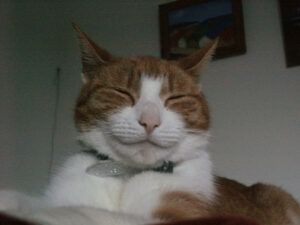
There are many ways a cat can gain happiness. It all depends on the cat, and what turns on his happiness switch. One of Carole’s clients told her that her cat, Ms. Marple, is in complete ecstasy when sprawled out in the kitchen sink.
Ms. Marple’s person says it is not unusual for the cat to bring her the sink stopper as a token of affection. The cat probably enjoys the coolness and feels relaxed and secure there. Also, as Ms. Marple is all white, she’s been admired for matching the sink so well, and such positive associations reinforce her attachment.
As a cat devotes his life to gratifying his basic needs, these actions bring him happiness. The cat’s first commitment is to himself. If such action pleases you in turn, consider it a gift.
If you can interpret your cat’s signals as to what makes him happy, you will become more adept at helping him stay in that good place.
Ch. 4: Sadness Or Discomfort
In a cat, sadness is not always an easy emotion to pick up on. Also, the sadness may be triggered by some physical problem that has the cat uncomfortable. When he is internally uncomfortable, his behavior becomes abnormal or bizarre, as he is trying to communicate his problem to you.
As an example, a cat may become anxious because of a strange environment. This stress affects the most vulnerable and sensitive part of his body.
If you can minimize the causes that stress your cat, you can help avoid medical problems. Because emotional anxiety can trigger health issues, the more of these anxiety-provoking situations you can avoid. the better.
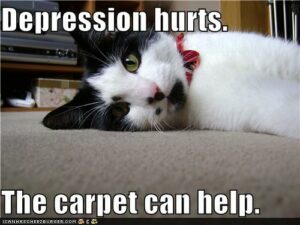
If you leave for more than a day, make sure to have someone come in and feed the cat twice a day. It is essential for your cat to have human contact. When you are gone, your cat is apt to become depressed, making him a perfect target for sickness.
On Spruce Island, when my Sam-Cat died, Lou, who was the love of his life, became very depressed. She spent her days sleeping in the bed they’d shared. She would come downstairs for meals, but would not stay.
Then, one evening I started playing with her sister, Poo, with a string toy. Lou could see us from her loft bed, and finally, she came downstairs to join the game. After that, I played with them regularly each evening, and Lou’s depression at last disappeared. Luckily, no illness came from her sad spell.
Ch. 5: Rage
Rage is usually very easy to recognize. The cat’s ears flatten, his pupils dilate, his back ripples, his tail jerks, and he may emit an unnerving yowl that may continue for a while. Do not try to pick up your cat when he is angry.
What could happen if you did: The cat may transfer his rage to you, and you could become the victim of an attack.
Sources of rage can be caused by a variety of factors. Carole gave an example from a friend who said one day he was sitting on the bed removing his shoes when the cat started to sniff them.
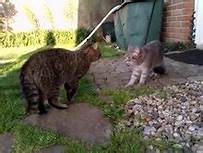
The friend said that the cat suddenly began making guttural noises and his whole body puffed up. The friend realized he’d just visited folks who had a cat and a dog, and he had petted them. Apparently, his shoes still carried their scents, and his cat became enraged.
As soon as the shoes disappeared, the cat calmed down. The cat became threatened by the scent of the shoes, and his rage protected him against the threat.
Ch. 6: Expressions Of Anxiety
If a cat feels insecure and endangered by an alien cat, when he’s anxious he attacks the source of his anxiety, even if he has transferred aggression to an innocent bystander.
Anxiety can turn to fear or worry. Don’t become a victim of your cat’s displaced aggression. Use water to distance him and cool him off when he becomes aggressive.
Carole talks of a four-year-old cat named Rosenante who lives with her companion cat, D.Q. Both cats are neutered.
One night an alien cat entered their apartment through an open window, and was there long enough to terrify Rosenante. The next morning Rosenante hissed and batted at D.Q. for no apparent reason. Because Rosenante was so upset, she couldn’t discriminate and transferred her hostility to her companion cat.
Carole recommended a tranquilizer to help relieve Rosenante’s anxiety, and said she should probably be kept on the medication for a couple of days. Once her anxiety was relieved, she returned to her old self.
Carole goes on to say that tranquilizers do not hurt a cat in any way when they’re carefully prescribed by a veterinarian. When a cat is hurting inside from continuing anxiety, that hurt or discomfort must be allayed or the stress will often lead to physical problems.
Your own anxiety can affect your cat’s peace of mind. Their activity level may amp up and they may give vocal expressions to their own anxiety. It is important that you pay attention to their reactions and don’t ignore them, as they could lead to a worse problem.
This chapter has several interesting examples of cat anxiety, which can give you clues so you will know how to handle such problems.
Ch. 7: Choice
Cats have definite ideas about what they consider their ideal living situation and who they want for companions. If we are able to honor their choices, they will be happier, healthier cats. This chapter discusses cats’ relationships, giving examples of good ones and occasionally bad ones. It enlarges on the concept that often a companion cat will bring happiness.
Often a good choice will lead to great friendships, and companion cats will love and care for each other. Pay attention to the cat’s behavior, and with luck, you will find a perfect cat match. This chapter has several interesting stories about cats and their choices.
One story is about a cat who had the choice of going outdoors and ended up moving to a new home. His people and he lived in California, in a canyon that their cat, Jaboo, loved to explore. Sometimes he’d be gone for a couple of days, but always returned.
His people found they had to spend several months in New York City. One of the couple, Judy, had to leave ahead of time. During that period, Jaboo disappeared for several days. Finally, after posting a notice, they received a phone call from folks who said Jaboo visited regularly; they didn’t know he had a home.
As the time for the departure to New York City came closer, they worried about what to do with Jaboo. Then he disappeared for a few days, and the folks whom he’d visited earlier called to say he was there.
When Jaboo’s new friends learned about the move to the city, they called and offered to adopt him. Jaboo’s people realized he had made the choice for them, and he moved to his new home.
Ch. 8: Eating Patterns
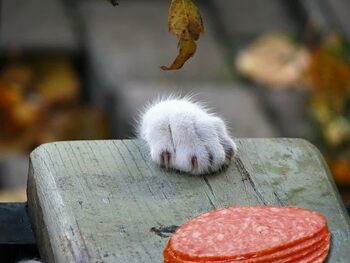
Cats have definite eating styles, when it comes to dinner-time. Some of them are dainty eaters, and some are very robust eaters. Some cats don’t want any distractions and some cats like to be petted while they eat.
My Pogo has his own style. I feed him in the office by my computer, and I stay right there while he eats. If I leave, often he will leave also.
He goes through the first half of his food quickly. Then I must persuade him to eat the second half. Often I will hold his bowl up off the floor so it is closer to him. He seems to like that.
Sometimes if a cat doesn’t like or want his food, he’ll scratch around it like he’s trying to bury it. You are expected to do something about the problem he is having.
The chapter describes many feeding scenarios, some enlightening and some amusing. After all, food is a basic necessity and there is no surprise that a cat’s attitude toward it can vary from one animal to another.
If a cat eats too fast it can lead to digestive problems, so it’s best to give this cat a smaller serving and give him a third meal during the day.
In the wild a cat may eat several times a day, as the animal is continually hunting for another meal. I’ve found with Pogo that he likes his meals divided into smaller portions. His large meals are offered up in two servings. I always make sure there’s extra food in the bowl at night, because he likes to snack a couple of times during the night.
Some cats are drawn to a certain unusual food because of some dietary need. Carole talks about Thomas, who craved vegetables, especially broccoli and beans. When it occurred to her that these supplied an excellent source of Vitamin C, she understood his craving.
supplied an excellent source of Vitamin C, she understood his craving.
Because of a chronic urinary problem, the cat needs a daily dose of Vitamin C, and by some means he became attracted to a natural source of the vitamin.
Ch. 9: Toilet Habits
A clean litter box is very important. A cat should not have to use the rug or bathtub because his litter box is either too wet or too full. Clean it often — and wash the box frequently to reduce odor.
Some cats are comfortable with a litter box and some cats really prefer to use the outdoors. Sometimes health problems such as parasites can cause a cat to reject his litter box. Sometimes other health problems can be the cause, and a full exam may give answers.
Pogo, a cat I’d known for a long time, ended up in the shelter because he wouldn’t use his litter box. He preferred the floor and especially the carpet. I learned that cats often do not like a covered litter box, which he had always had. When I took him home, I got him two extra-large litter boxes with no covers. Problem solved: he uses his box regularly.
Be aware that constipation and chronic urinary problems can also cause litter box avoidance. You can get the proper laxative to alleviate the problem.
Carole discusses the case of a very anxious and insecure cat who needed constant contact and attention. When the cat became anxious, he internalized the feelings, and his stress targets — his bladder and rectum — would be affected. Extreme constipation was the result.
Once Carole considered the cat’s case history, she saw that he needed a great deal of attention to help raise his self-esteem. With extra emotional support and increased laxative medication, his stress level dropped. Then he no longer needed extra medication.
Litter box problems are quite common, but a well-balanced diet, frequent grooming, and minimum stress can aid in stabilizing your cat’s regularity. You can give him a little butter if his stool needs softening, or you can use a commercial laxative.
For a soft stool try giving him rice, cheese, or pasta. If the cat has problems with regularity, try to resolve his stress-causing issues.
If your cat is having a problem, pay attention to the signals he gives. He will try to let you know what is wrong.
Ch. 10: Breathing
Observe your cat’s breathing, as he will often give you an idea of his feelings and health.
Rapid cat breathing is caused by temporary stress. For example, a trip to the vet could bring on such a reaction, but it will pass quickly, as soon as the cause is removed.
However, with long-term stress, the cat’s body becomes tense, his muscles contract, and his breathing is abnormal. Then he becomes more vulnerable to sickness, which will affect the weakest part of his body.
If your cat’s breathing is noticeably irregular, it is a good idea to get a vet check. When your cat develops a breathing problem, you first need to recognize the many factors involved. Then you must devise a treatment plan that deals as adequately as possible with the initial symptoms.
This treatment process may have to be adjusted a few times before the problem is stabilized. With patience and understanding, the process will eventually produce the desired result.
Ch. 11: Sex
Just as with people, the issue of sex can cause many problems. In this chapter, Carole gives examples. She talks about two unspayed female cats she visited in Hartford, CT.
The cats had had their first heat, and Carole explained to the cats’ person that when the two female cats reach sexual maturity, they can experience discomfort and rivalry.
Unless a cat is bred, each time she has a heat she won’t ovulate. This can cause the follicles in her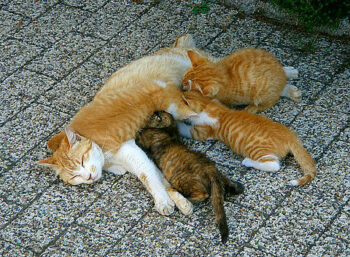 ovaries to become cystic. Hormone imbalance can trigger personality disorders.
ovaries to become cystic. Hormone imbalance can trigger personality disorders.
As their hormone levels drop, the cats will become more relaxed. They will feel and act calmer. Carole reassured the owner that spaying them would not cause them to lose their sensuality.
Because cats are mainly controlled by their feelings, they don’t think things out rationally, but are more concerned with satisfying their needs in the most direct way possible.
Often an unspayed female will show hostile or aggressive behavior toward people. Once spayed, the cat’s anxiety level decreases and she will no longer feel the need to attack to protect herself.
Carole shares interesting stories about unspayed cats, pregnant cats, and male cats who have just reached sexual maturity. Spaying and neutering can fix a wide range of problems.
When I lived on Spruce Island and adopted the two feral female kittens, they first came into heat within two weeks of each other. Sam was not interested in their advances, so they hiked the quarter mile to my neighbor’s place and began acting the floozie around his neutered male.
The neighbor received visits from first one cat, then the other. Finally, he came to my house and said if I didn’t take those cats to town and get them spayed, he would do it himself. I wasted no time taking them to the vet.
Ch. 12: Relationships
Often when a cat is alone a great deal, he can become bored or lonesome. Called the “single cat syndrome,” Carole explains that the cat feels neglected and lonely, and his pent-up energy can be channeled into mischief and destructive behavior.
The cat could also suffer anxiety attacks, in which he becomes aggressive or hostile toward people.
Very often these problems can be stopped if the cat’s person adds a new kitten to the family. Often this companion can provide a constructive release for the cat’s pent-up energy.
You will read a number of stories of how matching the cat with the right kind of kitten — one that would be able to keep up with the big cat, but not be a threat — and many of these problems can be solved.
This chapter also gives advice as to how to introduce the two cats and how you should interact with them as well.
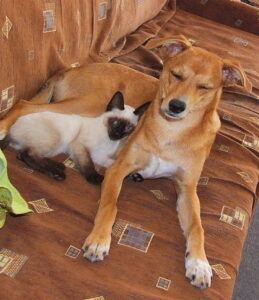
Sometimes a relationship with a dog will provide the cat with a companion and loss of loneliness. Cats and dogs are not natural enemies. However, realize that the two can be affected by their environment.
A good relationship that can be developed between two animals will lead to more contentment for them both.
Ch. 13: Cats’ Reactions To Their People’s Feelings And Body Language
When a cat’s people become extremely stressed, the cat realizes it and may react by becoming stressed himself. This behavior can lead to physical disorders.
Because the cat communicates primarily through sounds and body language, he can become very sensitive to his person’s stress. Whenever you can, try to pass on a positive feeling. Be aware that you can affect your cat if you become too negative.
In this book you will read a number of stories sharing how the person’s state of mind affected their cat. Giving the cat more attention is one solution to this problem.
Carole talks about how a couple’s separation can affect their cat, and can trigger a physical disorder. On the other hand, very often a cat can add to their peoples’ enjoyment when it comes to sharing happy moments.
I feel I have not done this book justice with this report. Carole writes in a way that captures your interest and draws you in to her story. Her many anecdotes about cats provide great content. Hopefully you will read the book yourself so you can gain the most benefit from it.
If you would like your own copy, here is a link to Amazon, where you can purchase it. Be aware that as an Amazon affiliate, I will receive a very small commission from your purchase, but your price will not be affected.
Cat Talk: What Your Cat Is Trying To Tell You
by Pubs Choice
Price: $16.01

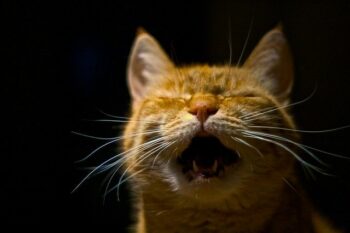

Loads of great information here. Very helpful in trying to understand our 4 outdoor cats. Each have totally different moods and actions.
Glad you found it helpful. Yes, cats are like us — they all have their different personalities. That adds to their charm, in my opinion. I’ve found that there is always one more thing to learn about these amazing creatures.